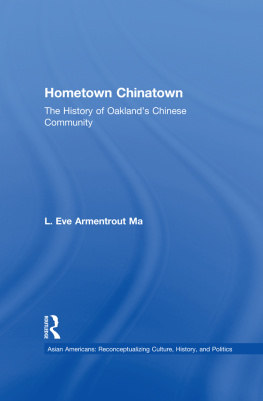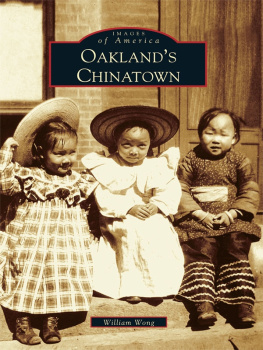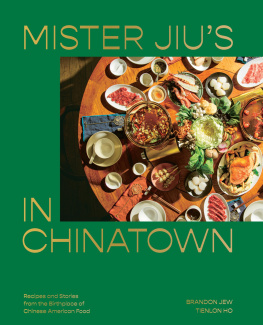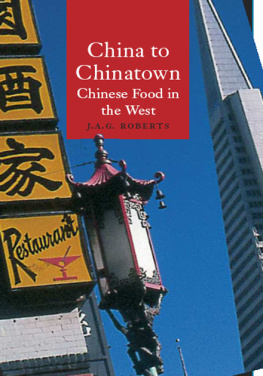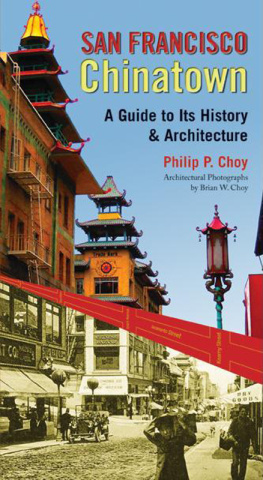A SIAN A MERICANS
R ECONCEPTUALIZING C ULTURE , H ISTORY, AND P OLITICS
editedby
Franklin Ng
CaliforniaStateUniversityFresno
HOMETOWN CHINATOWN
T HE H ISTORY OF O AKLANDS C HINESE C OMMUNITY
L. Eve Armentrout Ma
First Published in 2000 by
Garland Publishing, Inc.
A member of the Taylor & Francis Group
29 West 35th Street
New York, NY 10001
This edition published 2011 by Routledge:
Routledge
Taylor & Francis Group
711 Third Avenue
New York, NY 10017
Routledge
Taylor & Francis Group
2 Park Square, Milton Park
Abingdon, Oxon OX14 4RN
Copyright 2000 by L. Eve Armentrout Ma
All rights reserved. No part of this book may be reprinted or reproduced or utilized in any form or by any electronic, mechanical, or other means, now known or hereafter invented, including photocopying and recording, or in any information storage or retrieval system, without written permission from the publishers.
LibraryofCongressCataloging-in-PublicationData
Ma, L. Eve Armentrout.
Hometown Chinatown : the history of Oaklands Chinese community
p.cm(Asian Americans)
Includes bibliographical references and index.
ISBN 0-8153-3760-4 (acid-free paper)
1. Chinatown(Oakland, Calif.)History. 2. Chinese AmericansCaliforniaOaklandHistory. 3. Oakland(Calif.)History. 4. Oakland(Calif.)Ethnis relations. I. Title. II. Series.
F869.02 M3 2000
979.466dc21
00-057310
Table of Contents
I was lucky enough, when working on this book, to receive assistance and important information from a large number of individuals and organizations. Ambassador March Fong Eu, at that time California Secretary of State, whose political career began in Oakland, has written a Foreword for the book. Artist Dong Kingman drew a fine sketch of the area of Chinatown where he once had a restaurant, which appears in . William Sturm of Oakland Public Librarys History Room provided numerous historical photographs relating to Oaklands Chinese from the librarys collection.
In addition to these individuals, a former Oakland Chinatown community organization called the Oakland Chinese History Research Committee provided me with various types of information and assistance in the late 1970s, and directed me towards knowledgeable community members who were willing to be interviewed. One result of this collaboration was an early, shorter account of the history of Oaklands Chinese, a book that is no longer in print. Committee members most active in helping me at that time included Erwin Chew, Connie Chang, Howard Ah-Tye, Ernest Chann, and the late Rev. Frank G. Mar. More recently, Howard Ah-Tye and Ernest Chann reviewed portions of this manuscript covering recent events. My daughter, Lucy Armentrout-Ma, and my friend Jody Schoenhard read much of the manuscript and gave me thoughtful comments on it. My thanks also to Garland Press and Dr. Franklin Ng, the editor of this series.
The people that I interviewed provided information which really could not have been obtained in any other way. I owe them a particular debt. They include: Ernest Chann, Charles Chao, Peter Chen, George Chew, William Dang, the late Gee Guey, Ben Hoang, Ira C. Lee, Dr. Lester Lee, Linette Lee, Sherman Lim, Toy Lim, Chew Long, the late Rev. Frank G. Mar, Becky Smith, Ed Tom, Kevin Tom, Chuong Tran, Edward Wong, the late Taam Wu, Dr. Jacob Yee and Shuck Yee. There are others as well, too numerous to mention, but all are referred to in the Notes at the end of the book.
Last but not least, I would like to thank my friend Richard J. Lee, Esq., for legal services without which this book could not have seen the light of day; and even my sons, William M. Ma and Edward B. (Ted) Ma, who did some of the typing, and my former husband, Jeong-Huei Ma, who helped research the immediate post-1906 earthquake period.
The Chinese have always been builders. For centuries, they have built social systems which constitute the foundation of one of the greatest, most enduring civilizations of the world. They built the Great Wall of China, the only man-made structure on earth visible from the surface of the moon. In America, they helped expand the burgeoning young nation, laboring on the railroads, in the mines, and building dams, such as the Temescal and Chabot in Alameda County.
As we move into the 21st century, the pride, enterprise, and courage of the Oakland Chinese community have pioneered major business and residential construction in the citys Chinatown area. While some Chinese communities are intimidated by the size and scope of San Franciscos Chinatown, the largest in the nation, Oakland, located just across the bay, is not cowed by such comparisons. The people and their spirit have created projects for living from their dreams, such as the outstanding social services center, renovated from a former warehouse.
In this spirit of community pride and involvement, they have inspired this volume, a well-researched, comprehensive history of the Chinese in Oakland. The following pages reveal the cavalcade of outstanding, colorful men and women of the Oakland area who are as much builders in their own way as those who wield stone and masonry. These men and women and their supportive fellow citizens have made their niche not only in local history but regionally and nationally as well. Their foresight, courage, and deeds are chronicled within these pages.
Produced by Dr. L. Eve Armentrout Ma, with some assistance from members of the former Oakland Chinese History Research Committee and Jeong-Huei Ma, this remarkable volume records the history and accomplishments of a Chinese American community. As a Chinese American whose interest in serving in public life first began in the Oakland area, I am particularly proud of what has been achieved in this book. As this book shows, in their proud community achievements, Oakland Chinese Americans have created a blueprint for the future, an example which other Chinese American communities throughout the nation can certainly follow.
Ambassador March Fong Eu
In 1848, California became part of the United States. Almost simultaneously, gold was discovered at Sutters Mill. The great gold rush was on, luring hundreds then thousands then tens of thousands of 49ers to the gold country of the Sierra Nevada Mountains. On the coast, San Francisco was transformed from a remote military and missionary outpost into a major port, the point from which most adventurers disembarked to head for the mines. Ferry boats transported the miners from San Francisco up the Sacramento River to the Sierra foothills. From there, the miners pushed on, by pack mule or wagon or on foot into the mountains to search for gold.
The tremendous influx of fortune seekers changed everything in California, even back on the coast. Whaling towns like San Diego, Los Angeles and Monterey grew and developed facilities to reprovisioning ships laden with gold seekers bound for San Francisco. San Francisco expanded, and as its land became more and more expensive, other cities and towns like Oakland, San Jose and San Mateo grew up around the Bay, often built on land which squatters had stolen from Mexican owners.

